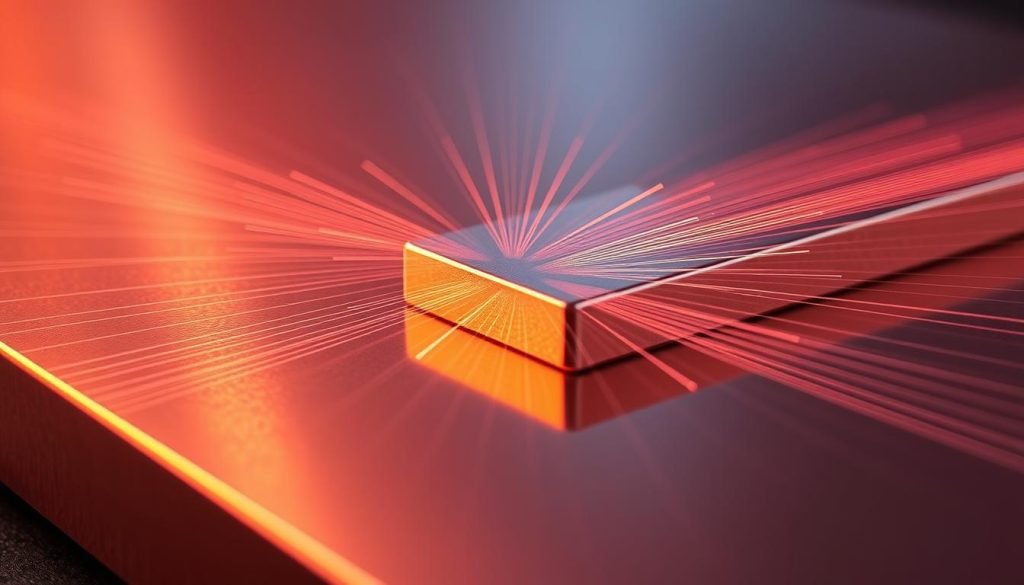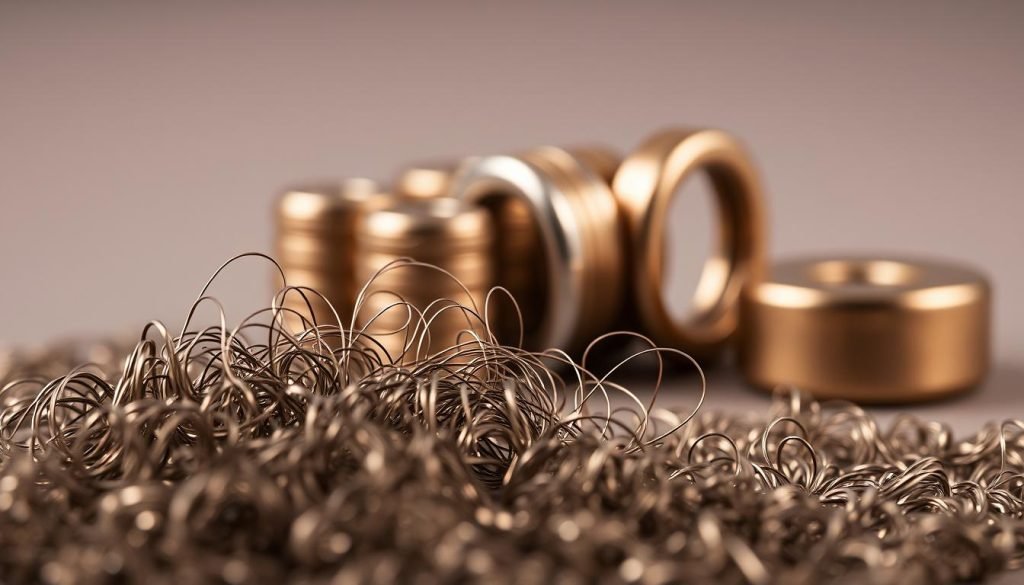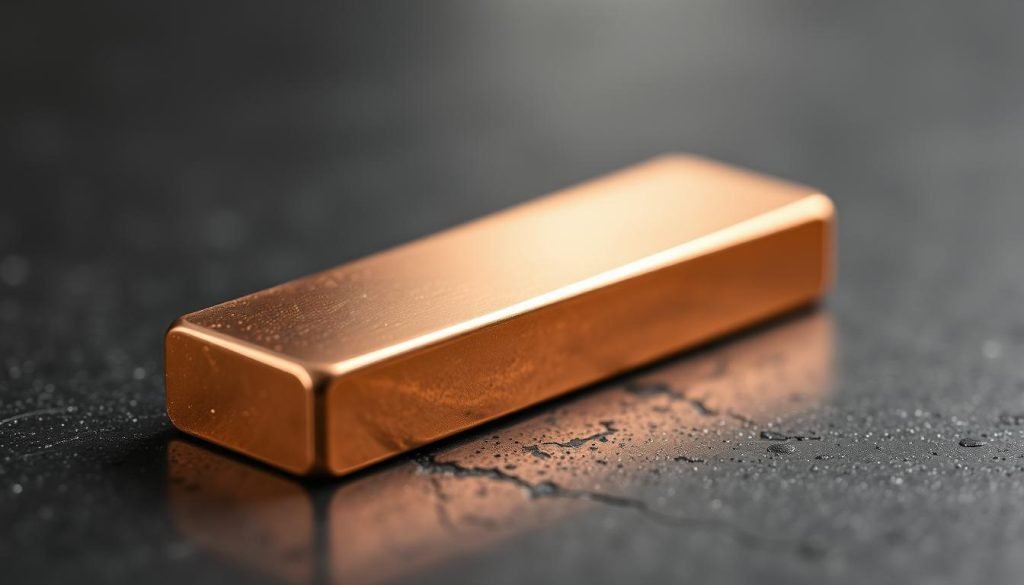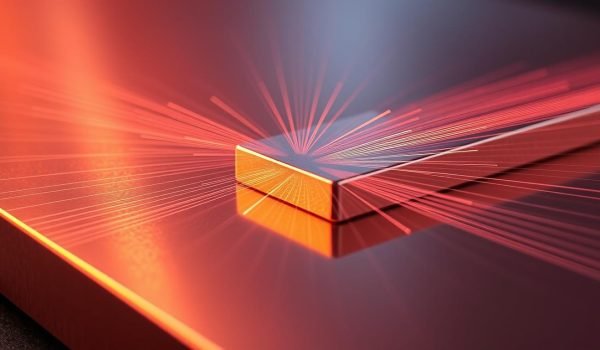You’ve likely wondered about the magnetic properties of various metals, and copper is no exception. Copper itself isn’t magnetic, but it does interact with magnets in fascinating ways.

When a magnet approaches copper, the magnetic field causes electrons on the copper’s surface to rearrange and rotate, creating resistance. This phenomenon is a result of copper’s unique properties at the atomic level.
Understanding how copper interacts with magnetic fields is crucial for various industrial applications and can help you make informed decisions in your projects.
Understanding Magnetism in Metals
The magnetic behavior of metals is determined by their atomic structure. In most materials, the atoms are not aligned into any sort of pattern, but when they are, the metal can exhibit magnetic properties.
What Makes a Metal Magnetic?
A metal becomes magnetic when its crystalline structure is aligned so that all the atoms face the same direction. Only ferromagnetic materials can be magnetized. Iron, Cobalt, and Nickel are the three elemental metals known to be magnetic.
Types of Magnetic Interactions
Metals interact with magnetic fields in different ways. Ferromagnetic materials are strongly attracted, while paramagnetic materials are weakly attracted. Diamagnetic materials, on the other hand, are repelled by magnetic fields. Understanding these interactions is crucial for understanding the properties of various metals.
Is Copper Magnetic? The Scientific Answer

To determine if copper is magnetic, we need to look at its atomic structure. Copper is a metal commonly used in various applications, including electrical wiring and electronics. But when it comes to magnetism, copper behaves differently than some other metals.
Properties of Copper at the Atomic Level
Copper’s atomic structure is key to understanding its magnetic properties. At the atomic level, copper has a filled d-orbital, which means it doesn’t have unpaired electrons that are typically responsible for ferromagnetism, as seen in iron. This filled orbital results in copper being diamagnetic, meaning it exhibits a weak repulsion to magnetic fields. You’ll find that this property is characteristic of materials that are not capable of being magnetized.
How Copper Responds to Magnetic Fields
When exposed to a magnetic field, copper doesn’t behave like ferromagnetic materials such as iron or nickel. Instead, copper is diamagnetic, showing a very weak repulsion to the magnetic field. This effect is usually negligible in everyday situations but becomes significant in certain scientific and industrial applications. For instance, when copper is subjected to a changing magnetic field, it can generate eddy currents, which are currents that flow in a conductor due to a changing magnetic field. These currents can sometimes be mistaken for magnetic properties, but they’re actually a different phenomenon altogether.
The Fascinating Relationship Between Copper and Electricity
You might be surprised to learn how copper, despite not being magnetic, interacts with magnetic fields to generate electricity. This phenomenon is crucial for many modern technologies. Copper’s excellent electrical conductivity makes it an ideal material for various electromagnetic applications.
Electromagnetic Induction in Copper
When a magnet is moved near a coil of copper wire, it induces an electrical current in the wire. This principle, known as Faraday’s law of electromagnetic induction, is the basis for many electrical generators. As the magnet moves, it creates a changing magnetic field around the copper wire, causing electrons to flow.
Eddy Currents: When Copper Seems Magnetic
Copper also exhibits another interesting phenomenon when interacting with magnetic fields: eddy currents. When a magnet is dropped through a copper tube, it induces currents in the tube’s walls. These eddy currents generate a magnetic field that opposes the motion of the magnet, slowing it down. This “magnetic braking” effect is used in applications like roller coaster braking systems and high-speed train braking.
By understanding the dynamic interaction between copper, electricity, and magnetism, you can appreciate the significance of copper in various industrial and technological applications.
Practical Applications of Copper’s Magnetic Properties
You can find copper’s magnetic properties at work in a wide range of everyday technologies. Copper’s excellent conductivity and unique electromagnetic characteristics make it an essential material in many industrial and technological applications.

Industrial and Engineering Uses
Copper is widely used in electromagnets, where its high conductivity allows for efficient creation of strong magnetic fields. Copper wire is wound around iron cores to create electromagnets used in various applications, including electric motors, generators, and transformers. The interaction between copper and magnetic fields is crucial for the operation of these devices.
Copper Alloys with Magnetic Properties
Copper alloys can be engineered to exhibit magnetic properties by combining copper with ferromagnetic elements like iron, nickel, or cobalt. These alloys are used in applications where both high conductivity and magnetic properties are required. The ability to tailor the magnetic properties of copper alloys makes them valuable in various technological applications.
Conclusion
Copper, though not magnetic itself, holds a special place in the realm of magnetism, influencing the behavior of magnetic fields in significant ways. You’ve learned that copper is diamagnetic, differing from ferromagnetic metals like iron and cobalt. Its valuable electromagnetic properties make it crucial for electrical applications.
FAQ
What determines if a metal is magnetic?
The magnetic properties of a metal are determined by its atomic structure, specifically the arrangement of electrons and the presence of unpaired electrons, which contribute to its overall magnetism.
How does copper respond to a magnetic field?
Copper is not ferromagnetic, but it can interact with magnetic fields through electromagnetic induction, generating an electromotive force when exposed to a changing magnetic field, and producing eddy currents that can create a magnetic field opposing the original field.
Can copper be made magnetic?
Copper itself is not magnetic, but it can be alloyed with other elements like nickel or cobalt, which are ferromagnetic, to create materials with magnetic properties, and when an electric current flows through copper wire, it generates a magnetic field.
What is the role of copper in electromagnetic systems?
Copper plays a crucial role in electromagnetic systems due to its high electrical conductivity, allowing it to efficiently carry electrical currents and facilitate the generation of magnetic fields, making it a key material in applications like electrical wiring, motors, and generators.
Are there any industrial applications that utilize copper’s interaction with magnetic fields?
Yes, copper’s interaction with magnetic fields is utilized in various industrial applications, including electromagnetic induction furnaces, magnetic resonance imaging (MRI) machines, and electrical generators, where copper windings are used to produce magnetic fields or detect changes in magnetic fields.
How do eddy currents affect copper’s behavior in magnetic fields?
Eddy currents induced in copper by a changing magnetic field can create a secondary magnetic field that opposes the original field, resulting in a phenomenon where copper appears to be repelled by or interacts with the magnetic field, even though it is not ferromagnetic.




